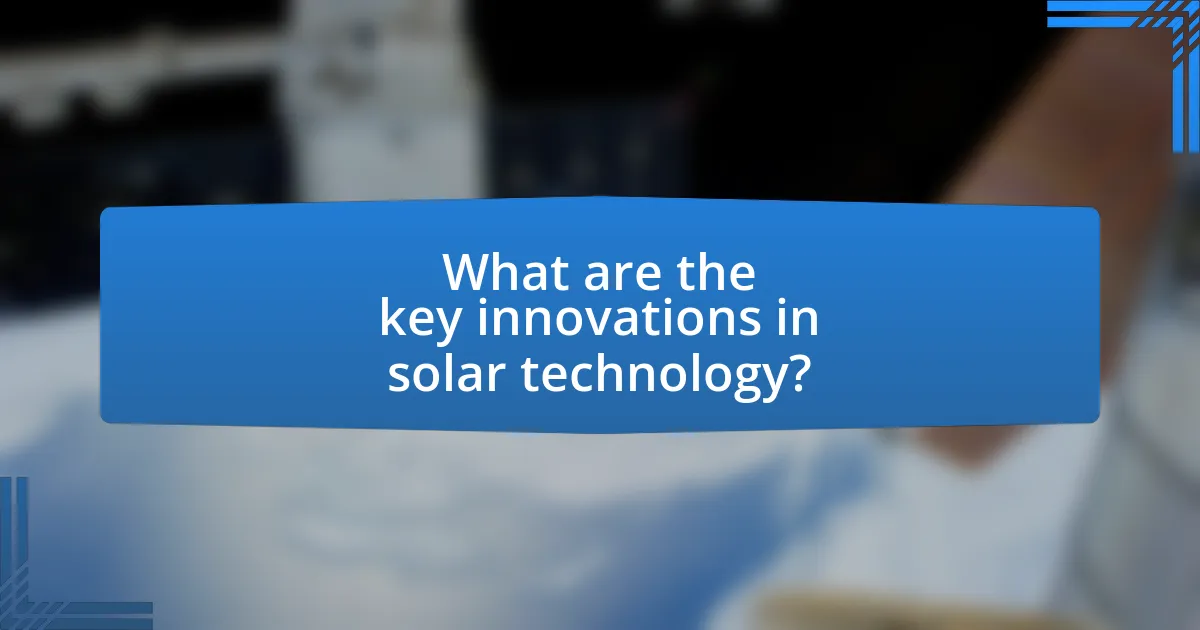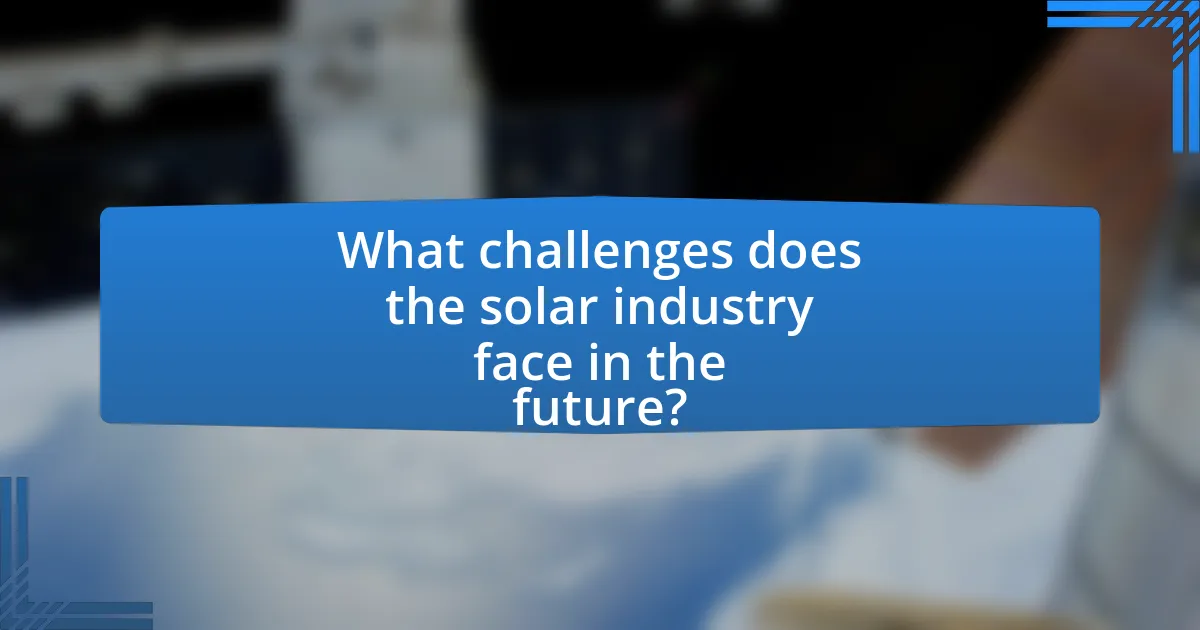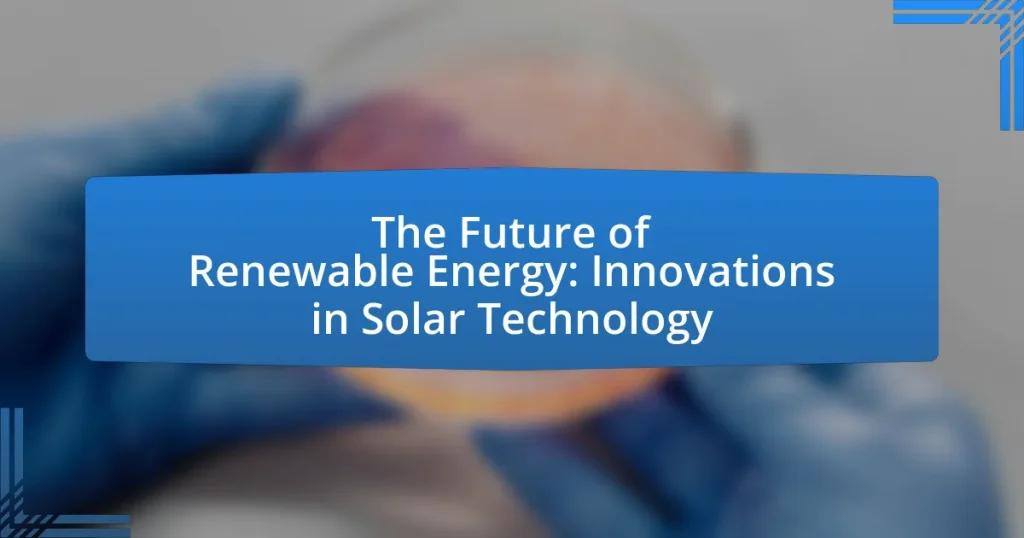The article focuses on the future of renewable energy, specifically highlighting innovations in solar technology. It discusses current trends such as the adoption of bifacial solar panels, advancements in energy storage solutions, and the integration of artificial intelligence for energy management. Key innovations driving solar panel efficiency, including perovskite solar cells and advanced tracking systems, are examined alongside the impact of government policies and financial incentives on solar technology adoption. Additionally, the article addresses challenges faced by the solar industry, environmental concerns related to solar panel manufacturing, and practical steps individuals can take to adopt solar technology.

What are the current trends in renewable energy and solar technology?
Current trends in renewable energy and solar technology include the increasing adoption of bifacial solar panels, advancements in energy storage solutions, and the integration of artificial intelligence for optimizing energy management. Bifacial solar panels, which capture sunlight on both sides, have gained popularity due to their higher efficiency and energy yield, with some installations reporting up to 30% more energy generation compared to traditional panels. Energy storage technologies, particularly lithium-ion batteries, are evolving rapidly, enabling better management of intermittent solar energy and enhancing grid stability. Furthermore, the use of artificial intelligence in solar technology is streamlining operations, improving predictive maintenance, and optimizing energy consumption patterns, thereby increasing overall system efficiency. These trends are supported by the International Energy Agency’s report, which highlights a significant growth trajectory in solar capacity and technological innovation in the renewable sector.
How is solar technology evolving in response to global energy demands?
Solar technology is evolving through advancements in efficiency, energy storage, and integration with smart grid systems to meet increasing global energy demands. Innovations such as bifacial solar panels, which capture sunlight on both sides, have improved energy output by up to 27% compared to traditional panels. Additionally, the development of perovskite solar cells has the potential to significantly lower production costs and enhance efficiency, with laboratory tests showing efficiencies exceeding 25%. Furthermore, the integration of solar technology with energy storage solutions, like lithium-ion batteries, allows for better management of energy supply and demand, enabling solar energy to be utilized even when sunlight is not available. These advancements collectively address the urgent need for sustainable energy sources as global energy consumption continues to rise, projected to increase by 50% by 2050 according to the International Energy Agency.
What innovations are driving advancements in solar panel efficiency?
Innovations driving advancements in solar panel efficiency include the development of bifacial solar panels, perovskite solar cells, and advanced tracking systems. Bifacial solar panels capture sunlight from both sides, increasing energy generation by up to 30% compared to traditional panels. Perovskite solar cells, which have shown efficiencies exceeding 25% in laboratory settings, offer a cheaper and more versatile alternative to silicon-based cells. Advanced tracking systems optimize the angle of solar panels throughout the day, enhancing energy capture by approximately 25%. These innovations collectively contribute to higher efficiency and lower costs in solar energy production.
How are energy storage solutions impacting solar technology?
Energy storage solutions significantly enhance solar technology by enabling the efficient use of solar energy even when sunlight is not available. These storage systems, such as batteries, allow for the capture and retention of excess energy generated during peak sunlight hours, which can then be utilized during periods of low or no sunlight. For instance, the integration of lithium-ion batteries with solar panels has been shown to increase energy self-consumption rates by up to 80%, according to a study by the National Renewable Energy Laboratory. This capability not only maximizes the utility of solar energy but also contributes to grid stability and reduces reliance on fossil fuels, thereby supporting the transition to a more sustainable energy future.
What role do government policies play in the future of solar energy?
Government policies are crucial in shaping the future of solar energy by providing financial incentives, regulatory frameworks, and support for research and development. These policies, such as tax credits, subsidies, and renewable energy mandates, encourage investment in solar technology and infrastructure. For instance, the Investment Tax Credit (ITC) in the United States has significantly boosted solar installations, contributing to a 167% increase in solar capacity from 2016 to 2020. Additionally, government regulations that promote clean energy standards help create a stable market for solar energy, driving innovation and reducing costs. Thus, effective government policies directly influence the growth and adoption of solar energy technologies.
How do incentives and subsidies affect solar technology adoption?
Incentives and subsidies significantly enhance solar technology adoption by reducing the financial burden on consumers and businesses. These financial mechanisms lower the upfront costs associated with purchasing and installing solar systems, making them more accessible. For instance, the U.S. federal solar investment tax credit allows homeowners to deduct a percentage of the installation costs from their federal taxes, which has been shown to increase residential solar installations by over 50% in areas where such incentives are available. Additionally, state-level rebates and feed-in tariffs provide further financial support, encouraging both individual and commercial investments in solar technology. Studies indicate that regions with robust incentive programs experience faster growth in solar capacity, demonstrating the direct correlation between financial incentives and increased adoption rates.
What regulations are shaping the solar energy market?
The solar energy market is primarily shaped by regulations such as the Investment Tax Credit (ITC), net metering policies, and renewable portfolio standards (RPS). The ITC allows homeowners and businesses to deduct a significant percentage of the cost of installing solar systems from their federal taxes, which has been a major driver of solar adoption in the United States. Net metering policies enable solar energy users to sell excess electricity back to the grid, providing financial incentives for solar installations. Additionally, RPS mandates that a certain percentage of energy must come from renewable sources, pushing utilities to invest in solar energy. These regulations collectively foster growth in the solar sector by enhancing economic viability and encouraging investment.

What are the key innovations in solar technology?
Key innovations in solar technology include bifacial solar panels, perovskite solar cells, and solar tracking systems. Bifacial solar panels capture sunlight from both sides, increasing energy generation by up to 30% compared to traditional panels. Perovskite solar cells, made from a unique crystal structure, have shown efficiencies exceeding 25% in laboratory settings, significantly improving upon conventional silicon cells. Solar tracking systems adjust the angle of solar panels throughout the day to follow the sun, enhancing energy capture by 20-50%. These advancements are supported by research from institutions like the National Renewable Energy Laboratory, which highlights the efficiency gains and cost reductions associated with these technologies.
How are new materials enhancing solar panel performance?
New materials are enhancing solar panel performance by increasing efficiency, reducing costs, and improving durability. For instance, perovskite solar cells have shown efficiencies exceeding 25%, significantly higher than traditional silicon cells, which typically max out around 22%. Additionally, materials like bifacial solar panels, which capture sunlight from both sides, can increase energy generation by up to 30%. Research published in “Nature Energy” by researchers at Stanford University highlights that these advanced materials not only improve energy conversion rates but also lower production costs due to simpler manufacturing processes. Furthermore, the integration of nanomaterials enhances light absorption and reduces energy loss, contributing to overall better performance in various environmental conditions.
What are the benefits of using perovskite solar cells?
Perovskite solar cells offer several significant benefits, including high efficiency, low production costs, and ease of manufacturing. Their efficiency has reached over 25%, comparable to traditional silicon solar cells, while their production costs can be reduced by using less expensive materials and simpler fabrication processes. Additionally, perovskite solar cells can be produced using solution-based methods, allowing for flexible and lightweight applications, which enhances their versatility in various environments. These advantages position perovskite solar cells as a promising technology in the renewable energy sector.
How does bifacial solar technology improve energy capture?
Bifacial solar technology improves energy capture by utilizing both sides of the solar panel to absorb sunlight, thereby increasing overall efficiency. This dual-sided design allows the panels to capture direct sunlight from the front and reflected sunlight from the ground or surrounding surfaces on the back. Studies indicate that bifacial panels can achieve energy gains of 10% to 20% compared to traditional monofacial panels, particularly in environments with high albedo, such as snowy or sandy areas. This enhanced energy capture is supported by research from the National Renewable Energy Laboratory, which highlights the effectiveness of bifacial technology in maximizing solar energy production.
What advancements are being made in solar energy integration?
Advancements in solar energy integration include the development of smart inverters, energy storage systems, and enhanced grid management technologies. Smart inverters facilitate the seamless connection of solar panels to the grid, allowing for better voltage regulation and reactive power support, which improves grid stability. Energy storage systems, such as lithium-ion batteries, enable the storage of excess solar energy for use during non-sunny periods, thereby increasing the reliability of solar power. Additionally, advanced grid management technologies, including artificial intelligence and machine learning algorithms, optimize energy distribution and consumption, enhancing overall efficiency. These advancements are supported by research from the National Renewable Energy Laboratory, which highlights the importance of integrating renewable energy sources into existing grid infrastructures to meet future energy demands.
How are smart grids facilitating solar energy distribution?
Smart grids facilitate solar energy distribution by enabling real-time monitoring and management of energy flow, which optimizes the integration of solar power into the electricity grid. These advanced systems utilize digital communication technology to enhance the efficiency and reliability of energy distribution, allowing for better demand response and load balancing. For instance, smart grids can automatically adjust energy distribution based on solar generation levels and consumer demand, reducing energy waste and improving grid stability. According to the U.S. Department of Energy, smart grid technologies can increase the integration of renewable energy sources, including solar, by up to 30%, demonstrating their critical role in advancing solar energy distribution.
What is the impact of solar microgrids on local energy systems?
Solar microgrids significantly enhance local energy systems by providing decentralized energy generation and improving energy resilience. These systems enable communities to generate their own electricity from solar panels, reducing reliance on centralized power grids and fossil fuels. According to a report by the National Renewable Energy Laboratory, solar microgrids can increase energy access in remote areas, decrease energy costs by up to 50%, and enhance grid stability during outages. Additionally, they facilitate the integration of renewable energy sources, contributing to lower greenhouse gas emissions and promoting sustainable energy practices.

What challenges does the solar industry face in the future?
The solar industry faces significant challenges in the future, including supply chain disruptions, technological advancements, and regulatory hurdles. Supply chain disruptions have been exacerbated by global events, such as the COVID-19 pandemic, which have led to shortages of critical materials like silicon and lithium. Technological advancements are necessary to improve efficiency and reduce costs, but the pace of innovation must keep up with market demands. Regulatory hurdles, including inconsistent policies and tariffs, can hinder growth and investment in solar projects. According to the International Energy Agency, achieving net-zero emissions by 2050 will require a substantial increase in solar capacity, highlighting the urgency of addressing these challenges.
How do economic factors influence solar technology development?
Economic factors significantly influence solar technology development by determining investment levels, research funding, and market demand. For instance, government incentives such as tax credits and subsidies can lower the cost of solar installations, thereby increasing adoption rates. According to the International Renewable Energy Agency, global investment in renewable energy reached $282 billion in 2019, highlighting the financial commitment to solar technology. Additionally, fluctuations in fossil fuel prices can make solar energy more attractive; when oil prices rise, the relative cost-effectiveness of solar increases, driving further innovation and development in the sector.
What are the implications of fluctuating material costs on solar production?
Fluctuating material costs significantly impact solar production by affecting the overall cost structure and profitability of solar projects. When the prices of key materials, such as silicon, metals, and glass, rise, manufacturers may face increased production costs, which can lead to higher prices for solar panels. For instance, a 2021 report indicated that silicon prices surged by over 300% due to supply chain disruptions, directly influencing the cost of solar modules. This increase can deter investment in solar energy, slow down deployment rates, and ultimately hinder the transition to renewable energy. Conversely, if material costs decrease, it can lead to lower prices for solar technology, stimulating market growth and adoption.
How does competition from other renewable sources affect solar energy?
Competition from other renewable sources, such as wind and hydroelectric power, affects solar energy by influencing market dynamics and investment allocation. As these alternative sources become more cost-effective and technologically advanced, they can divert funding and interest away from solar projects. For instance, the levelized cost of electricity (LCOE) for onshore wind has dropped to around $30 per megawatt-hour, making it a more attractive option for investors compared to solar energy, which averages around $40 to $60 per megawatt-hour. This shift can lead to slower growth in solar capacity and innovation, as resources are reallocated to more competitive renewable technologies.
What environmental concerns are associated with solar technology?
Environmental concerns associated with solar technology include land use, resource extraction, and waste management. The installation of large solar farms can lead to habitat destruction and biodiversity loss, particularly in sensitive ecosystems. Additionally, the production of solar panels involves the extraction of raw materials such as silicon, silver, and rare earth metals, which can result in environmental degradation and pollution. Furthermore, at the end of their lifecycle, solar panels can contribute to electronic waste if not properly recycled, as they contain hazardous materials like cadmium and lead. According to a study by the National Renewable Energy Laboratory, improper disposal of solar panels could lead to significant environmental risks, highlighting the importance of developing sustainable recycling methods.
How does solar panel manufacturing impact the environment?
Solar panel manufacturing impacts the environment primarily through resource extraction, energy consumption, and waste generation. The production process requires raw materials such as silicon, silver, and rare earth metals, which can lead to habitat destruction and pollution from mining activities. Additionally, the manufacturing process is energy-intensive, often relying on fossil fuels, which contributes to greenhouse gas emissions. For instance, a study by the National Renewable Energy Laboratory found that the lifecycle emissions of solar panels can be significant, with estimates ranging from 20 to 70 grams of CO2 equivalent per kilowatt-hour produced. Furthermore, the disposal of solar panels at the end of their life cycle poses environmental challenges, as they can contain hazardous materials that require careful management to prevent soil and water contamination.
What are the end-of-life considerations for solar panels?
End-of-life considerations for solar panels include recycling, disposal, and potential environmental impacts. Solar panels typically have a lifespan of 25 to 30 years, after which they may contain hazardous materials like cadmium and lead. Proper recycling processes can recover valuable materials such as silicon, silver, and glass, reducing waste and environmental harm. According to the International Renewable Energy Agency (IRENA), recycling can recover up to 95% of materials from solar panels, emphasizing the importance of establishing effective recycling programs. Additionally, regulations and guidelines are being developed in various regions to ensure responsible disposal and recycling, further supporting sustainable practices in the solar industry.
What practical steps can individuals take to adopt solar technology?
Individuals can adopt solar technology by first assessing their energy needs and evaluating their property for solar panel installation. This involves determining the average energy consumption and checking for adequate roof space and sunlight exposure. Next, individuals should research and select a reputable solar provider to obtain quotes and understand the available financing options, such as solar loans, leases, or power purchase agreements.
After selecting a provider, individuals can proceed with the installation process, which typically includes obtaining necessary permits and inspections. Once installed, individuals should monitor their solar system’s performance and maintenance needs to ensure optimal efficiency. According to the Solar Energy Industries Association, the U.S. solar market has grown significantly, with over 3 million solar installations as of 2021, demonstrating the increasing adoption of solar technology among homeowners.
How can homeowners evaluate the feasibility of solar installation?
Homeowners can evaluate the feasibility of solar installation by assessing their energy needs, roof characteristics, local solar incentives, and financial options. First, homeowners should analyze their average energy consumption to determine the size of the solar system required. Next, they must evaluate their roof’s orientation, angle, and shading, as these factors significantly impact solar energy production. Additionally, researching local solar incentives, such as tax credits or rebates, can provide financial benefits that enhance feasibility. Finally, homeowners should explore financing options, including loans, leases, or power purchase agreements, to understand the upfront costs and long-term savings associated with solar installation.
What are the best practices for maintaining solar panels?
The best practices for maintaining solar panels include regular cleaning, inspection, and monitoring of performance. Cleaning solar panels every six months or as needed ensures that dirt, dust, and debris do not obstruct sunlight, which can reduce efficiency by up to 25%. Inspecting the panels for physical damage, such as cracks or loose connections, should be done at least once a year to prevent further issues. Additionally, monitoring the system’s performance through a monitoring system can help identify any drops in energy production, allowing for timely maintenance. These practices are supported by studies indicating that proper maintenance can extend the lifespan of solar panels and optimize their energy output.


